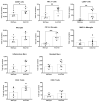Molecular, Cellular and Functional Changes in the Retinas of Young Adult Mice Lacking the Voltage-Gated K+ Channel Subunits Kv8.2 and K2.1
- PMID: 34063002
- PMCID: PMC8124447
- DOI: 10.3390/ijms22094877
Molecular, Cellular and Functional Changes in the Retinas of Young Adult Mice Lacking the Voltage-Gated K+ Channel Subunits Kv8.2 and K2.1
Abstract
Cone Dystrophy with Supernormal Rod Response (CDSRR) is a rare autosomal recessive disorder leading to severe visual impairment in humans, but little is known about its unique pathophysiology. We have previously shown that CDSRR is caused by mutations in the KCNV2 (Potassium Voltage-Gated Channel Modifier Subfamily V Member 2) gene encoding the Kv8.2 subunit, a modulatory subunit of voltage-gated potassium (Kv) channels. In a recent study, we validated a novel mouse model of Kv8.2 deficiency at a late stage of the disease and showed that it replicates the human electroretinogram (ERG) phenotype. In this current study, we focused our investigation on young adult retinas to look for early markers of disease and evaluate their effect on retinal morphology, electrophysiology and immune response in both the Kv8.2 knockout (KO) mouse and in the Kv2.1 KO mouse, the obligate partner of Kv8.2 in functional retinal Kv channels. By evaluating the severity of retinal dystrophy in these KO models, we demonstrated that retinas of Kv KO mice have significantly higher apoptotic cells, a thinner outer nuclear cell layer and increased activated microglia cells in the subretinal space. Our results indicate that in the murine retina, the loss of Kv8.2 subunits contributes to early cellular and physiological changes leading to retinal dysfunction. These results could have potential implications in the early management of CDSRR despite its relatively nonprogressive nature in humans.
Keywords: CDSRR; KCNB1; KCNV2; cone-rod dystrophy; photoreceptors; retinal degeneration; voltage-gated potassium channels.
Conflict of interest statement
The authors declare no conflict of interest. The funders had no role in the design of the study; in the collection, analyses, or interpretation of data; in the writing of the manuscript, or in the decision to publish the results.
Figures







Similar articles
-
The Role of the Voltage-Gated Potassium Channel Proteins Kv8.2 and Kv2.1 in Vision and Retinal Disease: Insights from the Study of Mouse Gene Knock-Out Mutations.eNeuro. 2019 Feb 25;6(1):ENEURO.0032-19.2019. doi: 10.1523/ENEURO.0032-19.2019. eCollection 2019 Jan-Feb. eNeuro. 2019. PMID: 30820446 Free PMC article.
-
Heteromeric KV2/KV8.2 Channels Mediate Delayed Rectifier Potassium Currents in Primate Photoreceptors.J Neurosci. 2018 Apr 4;38(14):3414-3427. doi: 10.1523/JNEUROSCI.2440-17.2018. Epub 2018 Feb 26. J Neurosci. 2018. PMID: 29483285 Free PMC article.
-
Characterization of the heteromeric potassium channel formed by kv2.1 and the retinal subunit kv8.2 in Xenopus oocytes.J Neurophysiol. 2007 Sep;98(3):1213-22. doi: 10.1152/jn.00493.2007. Epub 2007 Jul 25. J Neurophysiol. 2007. PMID: 17652418
-
Kv5, Kv6, Kv8, and Kv9 subunits: No simple silent bystanders.J Gen Physiol. 2016 Feb;147(2):105-25. doi: 10.1085/jgp.201511507. Epub 2016 Jan 11. J Gen Physiol. 2016. PMID: 26755771 Free PMC article. Review.
-
The role of voltage-gated ion channels in visual function and disease in mammalian photoreceptors.Pflugers Arch. 2021 Sep;473(9):1455-1468. doi: 10.1007/s00424-021-02595-2. Epub 2021 Jul 13. Pflugers Arch. 2021. PMID: 34255151 Review.
Cited by
-
The origins of the full-field flash electroretinogram b-wave.Front Mol Neurosci. 2023 Jul 3;16:1153934. doi: 10.3389/fnmol.2023.1153934. eCollection 2023. Front Mol Neurosci. 2023. PMID: 37465364 Free PMC article. Review.
-
Atp1b2Atp1b1 Knock-In Mice Exhibit a Cone-Rod Dystrophy-Like Phenotype.Cells. 2025 Jun 11;14(12):878. doi: 10.3390/cells14120878. Cells. 2025. PMID: 40558505 Free PMC article.
-
A versatile functional interaction between electrically silent KV subunits and KV7 potassium channels.Cell Mol Life Sci. 2024 Jul 14;81(1):301. doi: 10.1007/s00018-024-05312-1. Cell Mol Life Sci. 2024. PMID: 39003683 Free PMC article.
-
Analysis of the relationship between rod cell membrane currents and the photoreceptor component of electroretinograms using a cable model.Sci Rep. 2025 Apr 2;15(1):11211. doi: 10.1038/s41598-025-95998-5. Sci Rep. 2025. PMID: 40175484 Free PMC article.
-
Clarifying the composition of the ATP consumption factors required for maintaining ion homeostasis in mouse rod photoreceptors.Sci Rep. 2023 Aug 29;13(1):14161. doi: 10.1038/s41598-023-40663-y. Sci Rep. 2023. PMID: 37644037 Free PMC article.
References
-
- Wu H., Cowing J.A., Michaelides M., Wilkie S.E., Jeffery G., Jenkins S.A., Mester V., Bird A.C., Robson A.G., Holder G.E., et al. Mutations in the Gene KCNV2 Encoding a Voltage-Gated Potassium Channel Subunit Cause “Cone Dystrophy with Supernormal Rod Electroretinogram” in Humans. Am. J. Hum. Genet. 2006;79:574–579. doi: 10.1086/507568. - DOI - PMC - PubMed
-
- Wissinger B., Dangel S., Jagle H., Hansen L., Baumann B., Rudolph G., Wolf C., Bonin M., Koeppen K., Ladewig T., et al. Cone Dystrophy with Supernormal Rod Response Is Strictly Associated with Mutations in KCNV2. Investig. Opthalmol. Vis. Sci. 2008;49:751–757. doi: 10.1167/iovs.07-0471. - DOI - PubMed
-
- Wissinger B., Schaich S., Baumann B., Bonin M., Jägle H., Friedburg C., Varsányi B., Hoyng C.B., Dollfus H., Heckenlively J.R., et al. Large deletions of the KCNV2 gene are common in patients with cone dystrophy with supernormal rod response. Hum. Mutat. 2011;32:1398–1406. doi: 10.1002/humu.21580. - DOI - PubMed
MeSH terms
Substances
Grants and funding
LinkOut - more resources
Full Text Sources
Medical
Molecular Biology Databases
Research Materials

